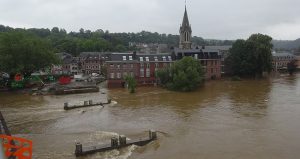European Commission liaises with Google on flood warning systems

-
 Fergal MacErlean
Fergal MacErlean
Share article:
Artificial Intelligence and social media is playing an increasing role in forecasting flood risks in Europe. In the EU, Member States are primarily responsible for preventing and preparing for floods, including issuing early warnings. However, an EU source said that the private sector “has an increasing role to play” in early warning systems through “their capacities in relation to data processing, computation and artificial intelligence.”
The source added that the European Commission’s science and knowledge service, the Joint Research Centre (JRC), “is involved in scientific exchange with the private sector, including Google, research organisations, as well as the relevant national authorities, to further develop flood early warning systems – such as the European Flood Awareness System (EFAS) of the Copernicus Emergency Management Service managed by the JRC.” It is remarkable that the European Commission is working together with Google while they are at the same time blaming the tech giant of abusive practices in online advertising technology.
Platform
EFAS provides a wide range of constantly updated early flood forecasting information to support national and regional flood risk management authorities to prepare before an event strikes. The JRC is also developing Social Media for Disaster Risk Management (SMDRM), a software platform that streamlines the processing of text and images extracted from Twitter in near real-time during a specific flood or other natural hazard event. The data is collected using a combination of keywords and locations based on daily forecasts from the early warning systems of the Copernicus Emergency Management Service.
Google Flood Hub
Google Flood Hub is providing flood forecasting across the EU as part of a May announced expansion of its AI based technology to 80 countries with the addition of territories in 60 new countries across Africa, the Asia-Pacific region, Europe, and South and Central America. The Flood Hub provides users with locally relevant flood data and flood forecasts up to seven days in advance. It displays local riverine flood maps and water trends and gives real-time flood forecasts. Flood Hub’s AI uses diverse, publicly-available data sources, such as weather forecasts and satellite imagery. The technology then combines two models: the Hydrologic Model, which forecasts the amount of water flowing in a river, and the Inundation Model, which predicts what areas are going to be affected and how deep the water will be. Google’s flood forecasting, updated daily, began in 2018 in India and expanded to Bangladesh to help combat the catastrophic damage from yearly floods. Last year it was available in 20 countries.
Public private cooperation
The private sector has a huge potential role to play in delivering Early Warnings for All initiative, through leveraging big tech and the power of Artificial Intelligence, the World Meterological Organization (WMO) said in a May 2023 Press Release. “A growing number of big IT companies are interested in contributing to Early Warnings for All,” said WMO Secretary-General Prof. Petteri Taalas. “The challenge of natural and man-made disasters and anthropogenic climate change and water resource impacts have to be tackled as a joint venture of the public and private sectors,” he said.
Floods Directive
Floods are the most common and most costly natural disasters in Europe. They are becoming more frequent due to climate change and have devastating effects, endangering lives and leading to heavy economic losses. According to the Floods Directive European Member States have to produce flood risk management plans. Recently sixteen Member States were urged to finalise their water plans for 2021-2027.
Research project
A new EU Horizon Europe project MedEWSa (Mediterranean and pan-European forecast and Early Warning System against natural hazards) will also provide state of the art natural hazard and extreme weather forecasting.













